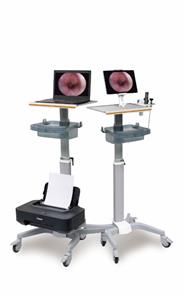Preparing the endoscope
Endoscopes require careful preparation in order to be used correctly, and the veterinary nurse plays a key role in this process. When setting up for an endoscopic procedure, the following steps should be followed:
Prior to use, visually inspect the endoscope for signs of damage. If you are using a flexible endoscope, perform a leak test at this stage too. If this shows evidence of a leak, do not use the endoscope, as irreversible damage may occur.
Appropriately position your endoscopy tower, connect your endoscope, camera and light cable (if required depending on the type of endoscope being used).
Connect any additional equipment required, such as a suction unit and tubing, and a distilled water bottle if using a gastrointestinal endoscope.
Turn the endoscopy tower on, attach a storage device (CD/USB) and enter the patient’s details.
Perform a white balance test (this ensures the colours appear realistic when viewing the screen), focus the endoscope (if a fibrescope is being used), and check the function of any attached suction, air and water. Ensure you do this before your patient is anaesthetised in case there is a problem with your endoscope!
After you’ve prepared your endoscope, you’ll need to go ahead and prepare all of your anaesthetic monitoring equipment and consumables for the procedure being performed. If you’ve not checked them out yet, be sure to head to our resource library for access to a free bundle of consumables lists for every common endoscopic procedure!
So that’s an introduction to endoscopy! How many endoscopies do you do in practice? Let me know below!
In the next few posts, we’ll be diving into endoscopy in lots more detail, including how to clean and maintain your endoscopes, what we do in each endoscopic procedure, and what our nursing considerations should be for these patients!




